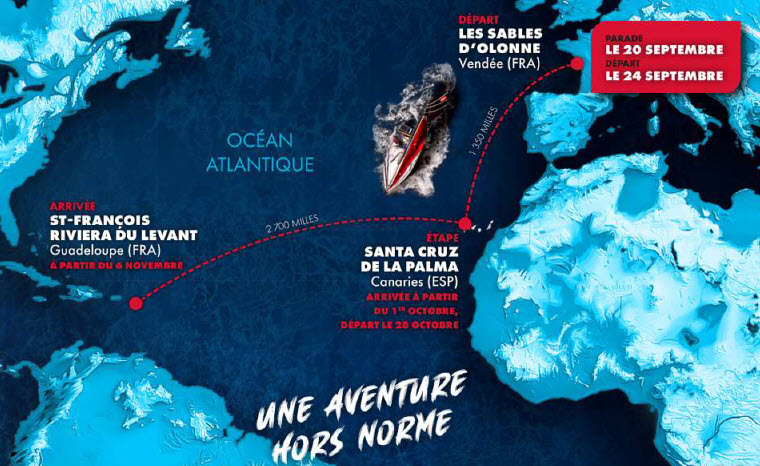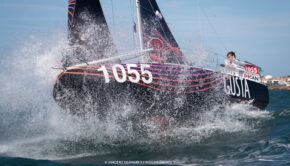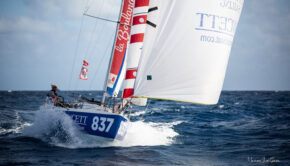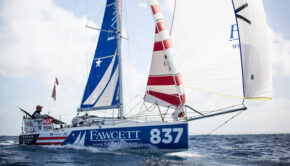Second stage for Mini Transat 2023
Published on October 28th, 2023
(October 28, 2023) – The 87 remaining competitors in the 24th edition of La Boulangère Mini Transat will set off today on the second leg of the race. They will depart from Santa Cruz de La Palma to reach Saint-François, Guadeloupe, covering a total of 2,700 nautical miles.
Everyone is preparing for the actual Atlantic crossing, with the only instructions being to leave the island of El Hierro and a waypoint located at 25° North and 27° West to starboard in order to avoid taking a route too far north. This route still carries a high risk of the formation of small tropical depressions.
The overall plan? The first miles are expected to be tricky due to light and unstable winds, as well as the wind shadow of the Canary Islands. The strategic aspect is wide open. In this context, some twists and turns are certainly not out of the question, but all solo sailors are well-prepared for the big leap!
If the first leg from Les Sables d’Olonne to Santa Cruz de La Palma (1,350 miles) gave them a taste of the challenge, the second leg from the Canary Islands to Saint-François (2,700 miles) will truly immerse them in the vast open sea. Once they leave the Spanish archipelago behind, the next coastline they will see will be Guadeloupe.
“This time, we’re heading for the ‘real’ crossing! The first leg was significant, but the one ahead is something else! There’s no turning back. We know we’re going to the Caribbean; the question is how?” remarks Aurélien Dhervilly (429 – XFLR6 Cherche Propergol).
Jean-Baptiste de Sansonetti (335 – Atlantique Solutions) shares the sentiment, “The safety harbors will be far, and we need to be cautious and preserve our equipment until the end. I expect to see very few boats on AIS, and to experience true solitude. It will be an adrenaline rush, but that’s precisely what we all seek in this adventure,” notes the skipper who, like all the others, dreams of well-established trade winds, long glides, and exciting surfs. While this is certainly part of the menu, they must first navigate the Canary Islands quickly, which may not be so simple.
“The weather situation is a bit peculiar. We expected to hoist the spinnaker when leaving La Palma and drop it when reaching Guadeloupe, but it may be more complex than that,” says Victoire Martinet (1031 – Chilowé). Indeed, light winds are forecasted for the end of the week in the area, and they will also have to contend with significant wind shadows, especially those generated by Tenerife and its famous Teide, towering at 3,715 meters above sea level, capable of extending over more than 60 nautical miles.
“A northeast flow of 5 to 6 knots is expected for the start. However, we can expect a bit more with the possible establishment of a thermal breeze, but the wind will quickly leave the area and shift to the northwest sector. It is expected to strengthen in the late afternoon tomorrow, but this indicates slow-paced early hours of the race,” details Denis Hugues, the Race Director.
Skimming Gomera? Going around El Hierro widely? It’s difficult at this point to define the best trajectories. The solo sailors will need to be opportunistic before seeing the full range of possibilities open up later.
“The start of the race will be a bit complicated to negotiate. It’s likely to be a bit of a puzzle, especially since we will quickly find ourselves upwind due to the passage of a front that wasn’t expected on this part of the course! However, the good news is that we should normally enjoy the famous trade winds afterward. These trade winds might even be quite strong and allow us to sail close to the direct route. In fact, the latest routings show us arriving in Guadeloupe in eleven or twelve days,” explains Julien Letissier (1069 – Frérots Branchet), third in the Proto class in the first leg, with only a 1 hour and 16-minute gap to the current leader, Spain’s Carlos Manera Pascual (1081 – Xucla).
Nevertheless, he knows that this second leg will certainly not be just a speed race, and significant lateral gaps are likely to form after rounding the virtual mark positioned almost on the orthodromic route.
“We are all well aware that, at this stage of the race, two-thirds of the course remains. The gaps created in the first leg are relatively small compared to what may exist in the second leg, especially as it promises to be quite strategic, with plenty of north-south choices,” says Bruno Lemunier (893 – Kalisto & Aérofab), third in the Series class at the end of the first round, 4 hours and 54 minutes behind the leader, Belgium’s Michaël Gendebien (921 – Barillec Marine – Actemium).
“In sailing, we know that a race is won at the finish line. Nothing is written yet. Personally, it’s clear that my result in the first leg is excellent and gives me high expectations. My initial goal was a top 10. I’m realizing now that I have the potential to do better than that, and I’m favorably positioned for the podium. However, I also know that if I don’t assume that I want to win this La Boulangère Mini Transat, I won’t win it,” says the designer, aware that in such an exercise, anything is possible, even the most unlikely.
“Past editions have often shown this,” reminds the sailor who is ready, like the majority of his competitors, to fulfill his dream of crossing the Atlantic and experiencing the adventure with a capital ‘A’.”
“Like many, including the top favorites who missed out on the first leg, my goal is to gain as many positions as possible compared to my current ranking (36th), which I’m not satisfied with. But above all, what I want is to learn, have fun, and reach the finish line. I really want to finish on the other side thinking that I gave it my all and have no regrets,” says Antoine de Vallavieille (914 – Petit Tonnerre), who, like most, has a multitude of questions in mind and some apprehensions as well.
“We’re all stepping into the unknown. We should be sailing with the wind in the right direction, which promises to be rather enjoyable. My concern, like many others, is a technical failure, such as the loss of the autopilot or a spinnaker, which would make me experience the transatlantic in a different way and leave me with a sense of incompleteness upon arrival,” concludes the sailor from Saint-Germain, summarizing the general feeling on the eve of the grand departure.
Event information – Tracker – Facebook
After a one day postponement due to storms, the 24th edition of the Mini Transat, reserved for the Mini 6.50, the smallest offshore racing class at 21-feet, saw the first stage get underway on September 25, 2023.
Ninety solo sailors entered the 2023 Mini Transat with the competitors placed in divisions for prototype and production boats.
A notable proving ground for sailors with shorthanded aspirations, it is also test platform for new boat types, with competitors entering in the production division for manufactured boats and the prototype division for custom designs.
Held biennially, with limited participation for safety that includes strict qualification guidelines, the 4,050 nm course is divided in two parts with the combined elapsed time to determine the results:
September 25: Les Sables d’Olonne (France) to Santa Cruz de La Palma in the Canaries (Spain) – 1350 nm
October 28: Santa Cruz de La Palma in the Canaries (Spain) to Saint-François in Guadeloupe – 2700 nm
Source: Versace Sailing Management










 We’ll keep your information safe.
We’ll keep your information safe.